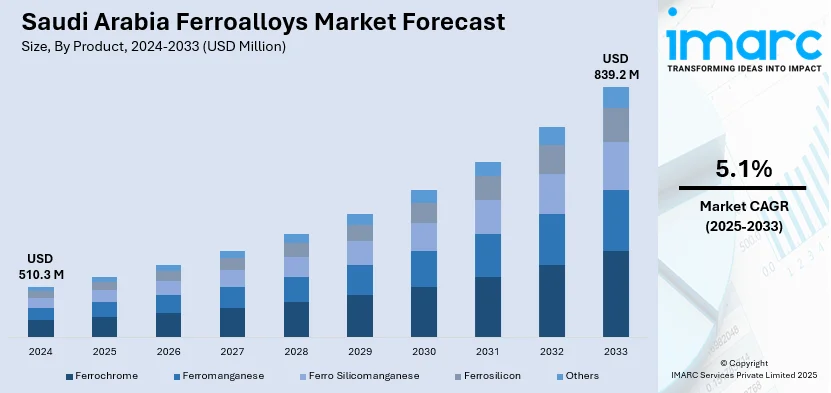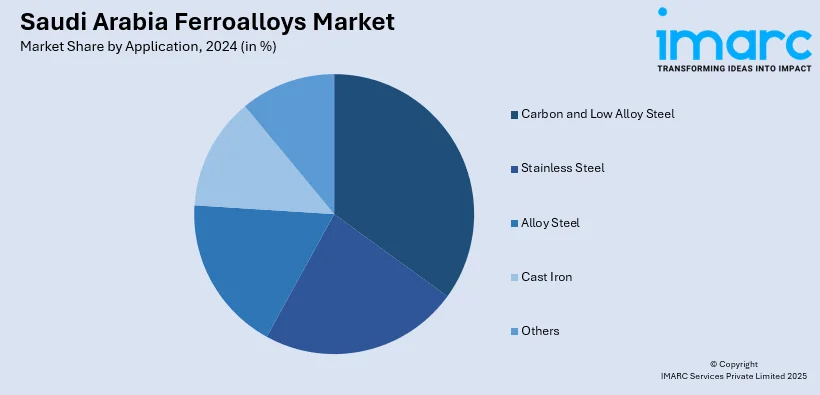
Saudi Arabia Ferroalloys Market Size, Share, Trends and Forecast by Product, Application, and Region, 2025-2033
Saudi Arabia Ferroalloys Market Overview:
The Saudi Arabia ferroalloys market size reached USD 510.3 Million in 2024. Looking forward, IMARC Group expects the market to reach USD 839.2 Million by 2033, exhibiting a growth rate (CAGR) of 5.1% during 2025-2033. Rising infrastructure development and the expanding energy and power sector in Saudi Arabia are catalyzing the demand for ferroalloys, as these materials are essential for producing high-strength, corrosion-resistant steel used in large-scale construction, energy transmission, and industrial equipment manufacturing.
|
Report Attribute
|
Key Statistics
|
|---|---|
|
Base Year
|
2024
|
|
Forecast Years
|
2025-2033
|
|
Historical Years
|
2019-2024
|
| Market Size in 2024 | USD 510.3 Million |
| Market Forecast in 2033 | USD 839.2 Million |
| Market Growth Rate 2025-2033 | 5.1% |
Saudi Arabia Ferroalloys Market Trends:
Rising Infrastructure Development
Saudi Arabia's ambitious infrastructure projects are playing a major role in the increasing demand for ferroalloys. With a major focus on developing smart cities, transport routes, energy infrastructure, and industrial parks under Vision 2030, the construction industry is experiencing heightened activity. For instance, in 2024, Saudi Arabia launched the $266 million Boulevard Business Park in Riyadh, marking the first phase of redeveloping the Boulevard District. The park spanned 60,000 square meters and included offices, retail outlets, and creative spaces. Such initiatives require substantial amounts of high-quality steel for applications in foundations, bridges, buildings, pipelines, and major engineering structures. Ferroalloys are crucial for producing the types of steel required for these demanding applications, as they improve the strength, hardness, and resistance to corrosion of steel. The drive for urban growth, along with large-scale projects like NEOM, the Red Sea Project, and the Riyadh Metro, is increasing domestic steel usage, thereby catalyzing the demand for ferroalloys utilized in structural and reinforcement steel. Moreover, state-supported investments in energy infrastructure, such as water desalination facilities and power plants, are also increasing the use of ferroalloy-enhanced steel parts. The growing complexity and scale of projects in both public and private sectors highlight the demand for specialized steel alloys, enhancing the importance of ferroalloys as a vital component in Saudi Arabia's infrastructure development.

Growing Use in Energy and Power Sector
The growth of Saudi Arabia’s energy and power industry is significantly contributing to the demand for ferroalloys. As the kingdom expands its energy portfolio and increases funding in both traditional and renewable energy projects, there is a rise in the demand for advanced steel grades in the production of equipment, structural frameworks, and transmission systems. Ferroalloys, crucial for enhancing the strength, heat resistance, and wear durability of steel, are vital for manufacturing parts that endure the challenging operational conditions common in power plants, energy storage solutions, and transmission networks. The growing development of substations, grid systems, and high-capacity transmission lines throughout Saudi Arabia is catalyzing the demand for specialized steel products, which in turn heightens the need for ferroalloys. Moreover, the focusing on the localizing production of equipment and decreasing reliance on imports is offering a favorable environment for domestic steel and alloy manufacturers. This requirement is not restricted to energy facilities based on fossil fuels but also encompasses new sectors like solar, wind, and hydrogen, where components enhanced with ferroalloys are utilized in panel structures, turbines, and pressure vessels. In 2024, Arctech secured a 2.3 GW solar project in Saudi Arabia, providing SkyLine II solar trackers for the PIF4-Haden project in partnership with ACWA Power. The project, part of Saudi Vision 2030, was set to become operational in 2027. As energy infrastructure strengthens and diversifies, ferroalloys are essential for ensuring the durability and reliability of the steel-heavy systems facilitating this transition.
Saudi Arabia Ferroalloys Market Segmentation:
IMARC Group provides an analysis of the key trends in each segment of the market, along with forecasts at the regional level for 2025-2033. Our report has categorized the market based on product and application.
Product Insights:
- Ferrochrome
- Ferromanganese
- Ferro Silicomanganese
- Ferrosilicon
- Others
The report has provided a detailed breakup and analysis of the market based on the product. This includes ferrochrome, ferromanganese, ferro silicomanganese, ferrosilicon, and others.
Application Insights:

- Carbon and Low Alloy Steel
- Stainless Steel
- Alloy Steel
- Cast Iron
- Others
A detailed breakup and analysis of the market based on the application have also been provided in the report. This includes carbon and low alloy steel, stainless steel, alloy steel, cast iron, and others.
Regional Insights:
- Northern and Central Region
- Western Region
- Eastern Region
- Southern Region
The report has also provided a comprehensive analysis of all the major regional markets, which include Northern and Central Region, Western Region, Eastern Region, and Southern Region.
Competitive Landscape:
The market research report has also provided a comprehensive analysis of the competitive landscape. Competitive analysis such as market structure, key player positioning, top winning strategies, competitive dashboard, and company evaluation quadrant has been covered in the report. Also, detailed profiles of all major companies have been provided.
Saudi Arabia Ferroalloys Market Report Coverage:
| Report Features | Details |
|---|---|
| Base Year of the Analysis | 2024 |
| Historical Period | 2019-2024 |
| Forecast Period | 2025-2033 |
| Units | Million USD |
| Scope of the Report |
Exploration of Historical Trends and Market Outlook, Industry Catalysts and Challenges, Segment-Wise Historical and Future Market Assessment:
|
| Products Covered | Ferrochrome, Ferromanganese, Ferro Silicomanganese, Ferrosilicon, Others |
| Applications Covered | Carbon and Low Alloy Steel, Stainless Steel, Alloy Steel, Cast Iron, Others |
| Regions Covered | Northern and Central Region, Western Region, Eastern Region, Southern Region |
| Customization Scope | 10% Free Customization |
| Post-Sale Analyst Support | 10-12 Weeks |
| Delivery Format | PDF and Excel through Email (We can also provide the editable version of the report in PPT/Word format on special request) |
Key Questions Answered in This Report:
- How has the Saudi Arabia ferroalloys market performed so far and how will it perform in the coming years?
- What is the breakup of the Saudi Arabia ferroalloys market on the basis of product?
- What is the breakup of the Saudi Arabia ferroalloys market on the basis of application?
- What is the breakup of the Saudi Arabia ferroalloys market on the basis of region?
- What are the various stages in the value chain of the Saudi Arabia ferroalloys market?
- What are the key driving factors and challenges in the Saudi Arabia ferroalloys?
- What is the structure of the Saudi Arabia ferroalloys market and who are the key players?
- What is the degree of competition in the Saudi Arabia ferroalloys market?
Key Benefits for Stakeholders:
- IMARC’s industry report offers a comprehensive quantitative analysis of various market segments, historical and current market trends, market forecasts, and dynamics of the Saudi Arabia ferroalloys market from 2019-2033.
- The research report provides the latest information on the market drivers, challenges, and opportunities in the Saudi Arabia ferroalloys market.
- Porter's five forces analysis assist stakeholders in assessing the impact of new entrants, competitive rivalry, supplier power, buyer power, and the threat of substitution. It helps stakeholders to analyze the level of competition within the Saudi Arabia ferroalloys industry and its attractiveness.
- Competitive landscape allows stakeholders to understand their competitive environment and provides an insight into the current positions of key players in the market.
Need more help?
- Speak to our experienced analysts for insights on the current market scenarios.
- Include additional segments and countries to customize the report as per your requirement.
- Gain an unparalleled competitive advantage in your domain by understanding how to utilize the report and positively impacting your operations and revenue.
- For further assistance, please connect with our analysts.
 Request Customization
Request Customization
 Speak to an Analyst
Speak to an Analyst
 Request Brochure
Request Brochure
 Inquire Before Buying
Inquire Before Buying




.webp)




.webp)












